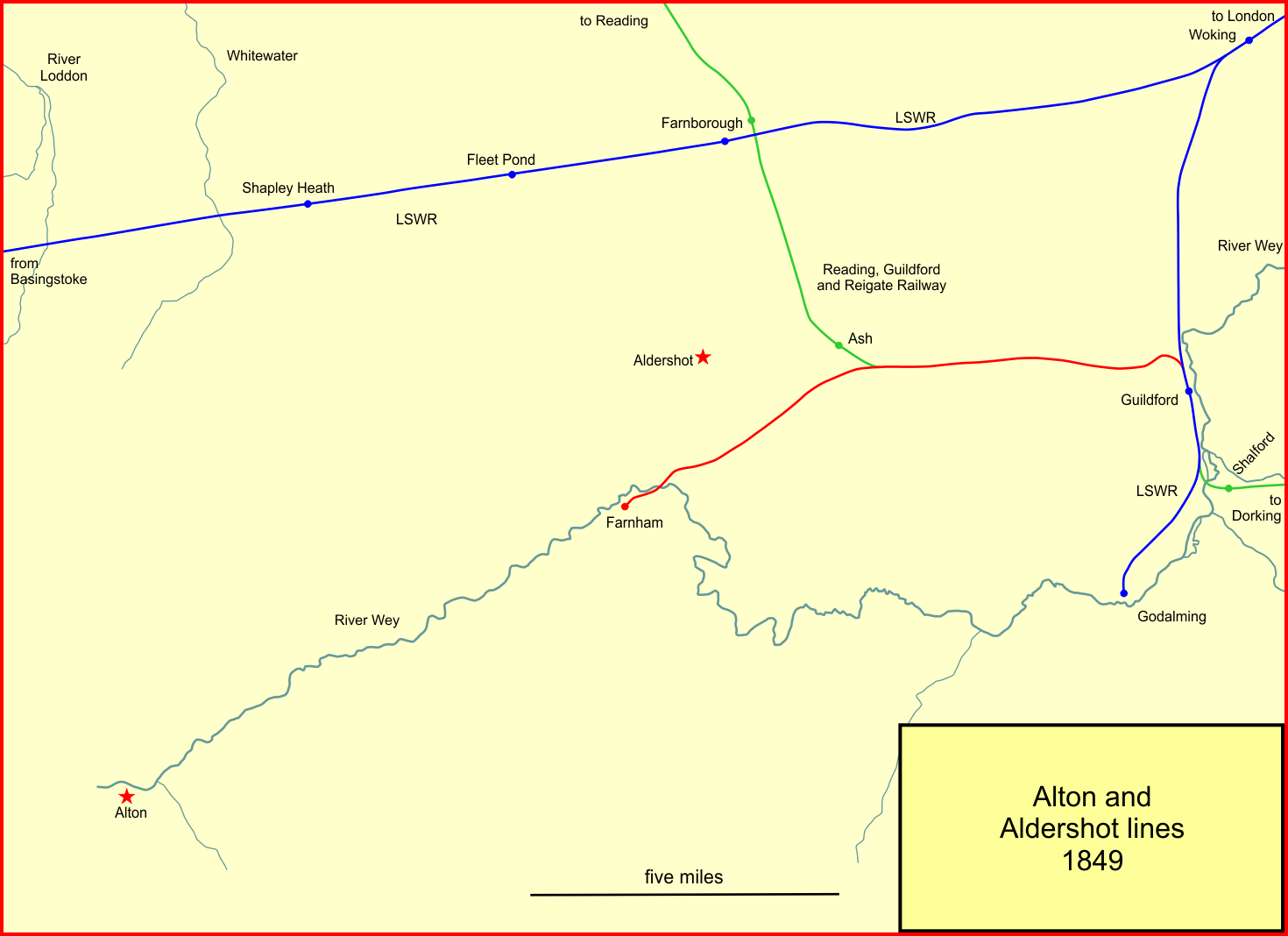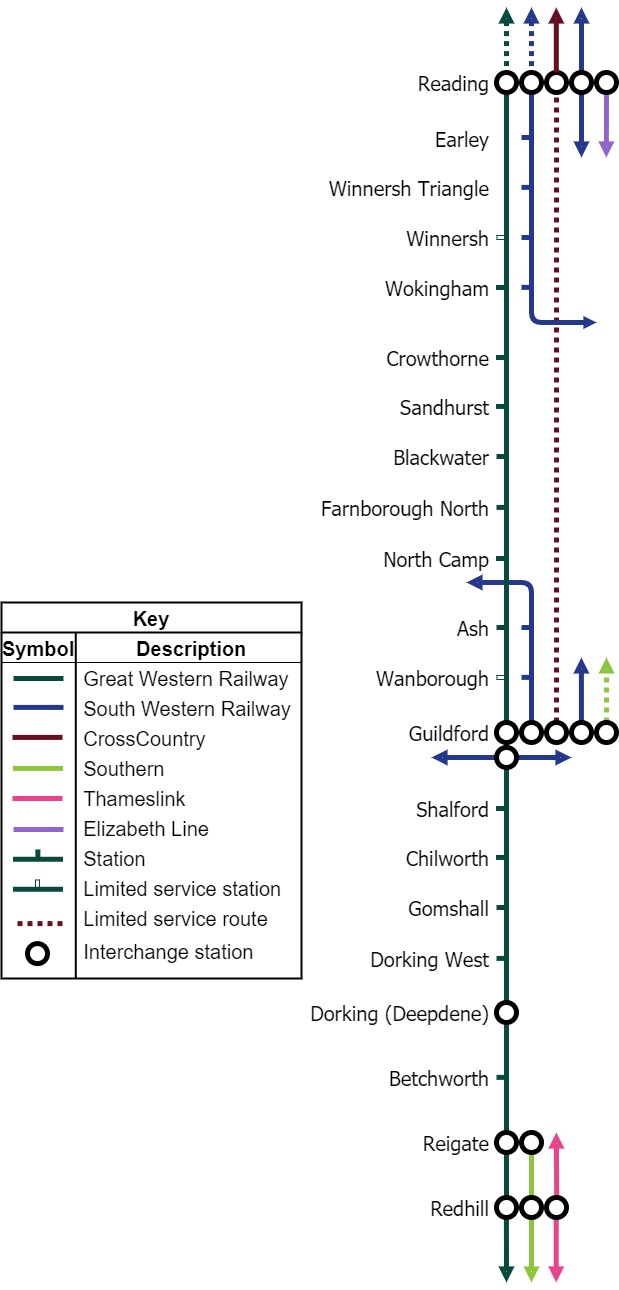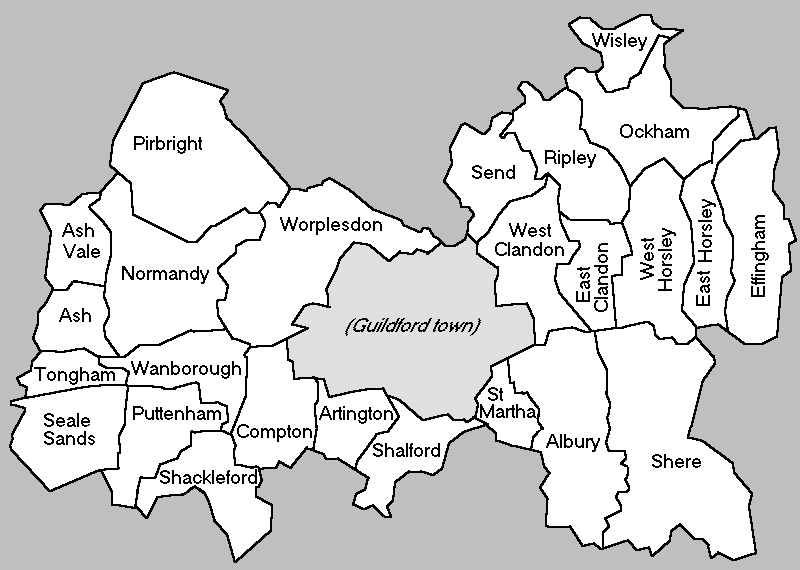|
Wanborough Railway Station
Wanborough railway station is in Flexford, Surrey, England. It serves the villages of Normandy to the north and Wanborough to the south. South Western Railway operates the station and most of the trains that serve it. Great Western Railway also provides a limited service. The station is on the Ascot to Guildford line and the North Downs Line, from . Services South Western Railway runs trains every 30 minutes Monday to Saturday, and every 60 minutes on Sundays between and . A few Great Western Railway trains between and call at Wanborough. History The London and South Western Railway opened the station on its Guildford to Aldershot line in 1891. British Rail British Railways (BR), which from 1965 traded as British Rail, was a state-owned company that operated most of the overground rail transport in Great Britain from 1948 to 1997. It was formed from the nationalisation of the Big Four British rai ...ways closed the station's signal box in 1966, ... [...More Info...] [...Related Items...] OR: [Wikipedia] [Google] [Baidu] |
Wanborough, Surrey
Wanborough () is a rural village and civil parish in Surrey approximately 4 miles (6 km) west of Guildford on the northern slopes of the Hog's Back. Wanborough lies between Puttenham and Normandy. Wanborough village grew around and to service Wanborough Manor which is on the site of ancient springs. History Prehistory According to a local publication ''Wanborough and its Church'', humans in prehistory travelled along the Hog's Back, attracted by the spring in the locality. The earliest settlement dates to 8000 BC. The "Wanborough Coins" are part of a votive offering deposited at a Romano-Celtic temple (i.e., late 1st century BC to 4th century AD); this site was looted between 1983 and 1985, but over one thousand silver coins, a small part of the original assemblage, were eventually added to the collection of the British Museum. The British Museum calls the destruction of the Romano-Celtic temple at Wanborough in Surrey 'one of the saddest stories in British archaeology ... [...More Info...] [...Related Items...] OR: [Wikipedia] [Google] [Baidu] |
Normandy, Surrey
Normandy is a civil parish of in the borough of Guildford in Surrey, England and the name of the largest village in that parish. Almost surrounded by its hill ranges, Normandy is in the plain west of Guildford, straddles the A323 'Aldershot Road' and is north of the narrowest part the North Downs known as the Hog's Back which carries a dual carriageway. The parish in 2011 had a population of 2,981 living in 1,310 households, has woods, a public common and four government-operated commons to the north that are an SSSI heath. Normandy has been home to a number of notable residents, including William Cobbett. Geography As well as the village of Normandy clustered around the crossroads of the Guildford-Aldershot Road (the A323), Hunts Hill Road and Glaziers Lane, the parish also includes Christmas Pie, Willey Green, Wyke, Flexford and Pinewoods. These hamlets, although distinct, are strung together in a swathe of development with largely residential use apart from Pinewoods th ... [...More Info...] [...Related Items...] OR: [Wikipedia] [Google] [Baidu] |
Railway Stations In Great Britain Opened In 1891
Rail transport (also known as train transport) is a means of transport that transfers passengers and goods on wheeled vehicles running on rails, which are incorporated in tracks. In contrast to road transport, where the vehicles run on a prepared flat surface, rail vehicles (rolling stock) are directionally guided by the tracks on which they run. Tracks usually consist of steel rails, installed on sleepers (ties) set in ballast, on which the rolling stock, usually fitted with metal wheels, moves. Other variations are also possible, such as "slab track", in which the rails are fastened to a concrete foundation resting on a prepared subsurface. Rolling stock in a rail transport system generally encounters lower frictional resistance than rubber-tyred road vehicles, so passenger and freight cars (carriages and wagons) can be coupled into longer trains. The operation is carried out by a railway company, providing transport between train stations or freight customer faciliti ... [...More Info...] [...Related Items...] OR: [Wikipedia] [Google] [Baidu] |
Former London And South Western Railway Stations
A former is an object, such as a template, gauge or cutting die, which is used to form something such as a boat's hull. Typically, a former gives shape to a structure that may have complex curvature. A former may become an integral part of the finished structure, as in an aircraft fuselage, or it may be removable, being using in the construction process and then discarded or re-used. Aircraft formers Formers are used in the construction of aircraft fuselage, of which a typical fuselage has a series from the nose to the empennage, typically perpendicular to the longitudinal axis of the aircraft. The primary purpose of formers is to establish the shape of the fuselage and reduce the column length of stringers to prevent instability. Formers are typically attached to longerons, which support the skin of the aircraft. The "former-and-longeron" technique (also called stations and stringers) was adopted from boat construction, and was typical of light aircraft built until the ad ... [...More Info...] [...Related Items...] OR: [Wikipedia] [Google] [Baidu] |
Railway Stations In Surrey
Rail transport (also known as train transport) is a means of transport that transfers passengers and goods on wheeled vehicles running on rails, which are incorporated in Track (rail transport), tracks. In contrast to road transport, where the vehicles run on a prepared flat surface, rail vehicles (rolling stock) are directionally guided by the tracks on which they run. Tracks usually consist of steel rails, installed on Railroad tie, sleepers (ties) set in track ballast, ballast, on which the rolling stock, usually fitted with metal wheels, moves. Other variations are also possible, such as "slab track", in which the rails are fastened to a concrete foundation resting on a prepared subsurface. Rolling stock in a rail transport system generally encounters lower friction, frictional resistance than rubber-tyred road vehicles, so passenger and freight cars (carriages and wagons) can be coupled into longer trains. The rail transport operations, operation is carried out by a ... [...More Info...] [...Related Items...] OR: [Wikipedia] [Google] [Baidu] |
London Waterloo Railway Station
Waterloo station (), also known as London Waterloo, is a central London terminus on the National Rail network in the United Kingdom, in the Waterloo area of the London Borough of Lambeth. It is connected to a London Underground station of the same name and is adjacent to Waterloo East station on the South Eastern Main Line. The station is the terminus of the South West Main Line to via Southampton, the West of England main line to Exeter via , the Portsmouth Direct line to which connects with ferry services to the Isle of Wight, and several commuter services around west and south-west London, Surrey, Hampshire and Berkshire. The station was opened in 1848 by the London and South Western Railway, and it replaced the earlier as it was closer to the West End. It was never designed to be a terminus, as the original intention was to continue the line towards the City of London, and consequently the station developed in a haphazard fashion, leading to difficulty finding the ... [...More Info...] [...Related Items...] OR: [Wikipedia] [Google] [Baidu] |
British Rail
British Railways (BR), which from 1965 traded as British Rail, was a state-owned company that operated most of the overground rail transport in Great Britain from 1948 to 1997. It was formed from the nationalisation of the Big Four British railway companies, and was privatised in stages between 1994 and 1997. Originally a trading brand of the Railway Executive of the British Transport Commission, it became an independent statutory corporation in January 1963, when it was formally renamed the British Railways Board. The period of nationalisation saw sweeping changes in the railway. A process of dieselisation and electrification took place, and by 1968 steam locomotives had been entirely replaced by diesel and electric traction, except for the Vale of Rheidol Railway (a narrow-gauge tourist line). Passengers replaced freight as the main source of business, and one-third of the network was closed by the Beeching cuts of the 1960s in an effort to reduce rail subsidies. On privatis ... [...More Info...] [...Related Items...] OR: [Wikipedia] [Google] [Baidu] |
Aldershot And Alton Lines Of The LSWR
The Aldershot and Alton lines of the LSWR (the London and South Western Railway) were railways developed from 1849 onwards in the region in Surrey and Hampshire, England, between the Southampton main line and Guildford. First was a line from Guildford to Farnham, soon extended to Alton in 1852. The Reading, Guildford and Reigate Railway, an affiliate of the South Eastern Railway (SER), used part of that line by running powers. When the Aldershot Garrison and associated camps opened, suddenly Aldershot had a large population, both civilian and military, and the LSWR built a line from Pirbright Junction, on the Southampton main line. As well as serving Aldershot, this line gave a more direct route from London. It opened in 1870. It was complemented by a short curve near Ash enabling trains from Guildford to reach Aldershot, opening in 1879. This formed an Aldershot loop that by-passed part of the original line, from Ash Junction through Tongham to Farnham Junction. Although th ... [...More Info...] [...Related Items...] OR: [Wikipedia] [Google] [Baidu] |
North Downs Line
The North Downs Line is a passenger-train line connecting Reading, on the Great Western Main Line, to Redhill and , along the Brighton Main Line, linking many centres of population in that part of the North Downs which it traverses en route. The route Between Redhill and Ash the line runs roughly parallel with the North Downs. Between Reigate and Gomshall the line runs along the foot of the North Downs escarpment in the Vale of Holmesdale. At Guildford it passes through the gap in the Downs formed by the River Wey, with two short tunnels just south of Guildford station, and further west between Guildford and Ash the line runs to the north of the Hog's Back. It then follows the Blackwater valley as far as Sandhurst, before continuing to Reading. History of the line's construction The line was authorised by Acts of Parliament in 1846 and 1847 and most of it was constructed by the Reading, Guildford and Reigate Railway Company (RG&RRC), opening in 1849. (A central section of the ... [...More Info...] [...Related Items...] OR: [Wikipedia] [Google] [Baidu] |
Great Western Railway (train Operating Company)
Great Western Railway (GWR) is a British train operating company owned by FirstGroup that operates the Greater Western passenger railway franchise. It manages 197 stations and its trains call at over 270. GWR operates long-distance inter-city services along the Great Western Main Line to and from the West of England and South Wales, inter-city services from London to the West Country via the Reading–Taunton line, and the ''Night Riviera'' sleeper service between London and Penzance. It also provides commuter and outer-suburban services from its London terminus at Paddington to West London, the Thames Valley region including parts of Berkshire, parts of Buckinghamshire and Oxfordshire; and regional services throughout the West of England and South Wales to the South coast of England. Great Western Railway also provides and maintains the Electrostar Class 387 fleet for Heathrow Express. The company began operating in February 1996 as Great Western Trains, as part of the pr ... [...More Info...] [...Related Items...] OR: [Wikipedia] [Google] [Baidu] |
Surrey
Surrey () is a ceremonial and non-metropolitan county in South East England, bordering Greater London to the south west. Surrey has a large rural area, and several significant urban areas which form part of the Greater London Built-up Area. With a population of approximately 1.2 million people, Surrey is the 12th-most populous county in England. The most populated town in Surrey is Woking, followed by Guildford. The county is divided into eleven districts with borough status. Between 1893 and 2020, Surrey County Council was headquartered at County Hall, Kingston-upon-Thames (now part of Greater London) but is now based at Woodhatch Place, Reigate. In the 20th century several alterations were made to Surrey's borders, with territory ceded to Greater London upon its creation and some gained from the abolition of Middlesex. Surrey is bordered by Greater London to the north east, Kent to the east, Berkshire to the north west, West Sussex to the south, East Sussex to ... [...More Info...] [...Related Items...] OR: [Wikipedia] [Google] [Baidu] |
Guildford (borough)
The Borough of Guildford is a local government district with borough status in Surrey, England. With around half of the borough's population, Guildford is its largest settlement and only town, and is the location of the council. The district was formed on 1 April 1974, under the Local Government Act 1972 by an amalgamation of the municipal borough of Guildford and Guildford Rural District. Functions Borough councillors and officers work on devolved issues such as parks, leisure, older residents' services, youth services, streetscene, refuse collection, planning and aspects of business and tourism; Surrey County Council deal with transport, publicly owned infrastructure planning and maintenance, education, social services and overall waste management. The Borough owns significant heritage assets that include monuments such as Guildford Castle, as well museums, art collections and civic regalia. Population Guildford has the second largest population of Surrey's eleven distri ... [...More Info...] [...Related Items...] OR: [Wikipedia] [Google] [Baidu] |




.jpg)


